NAAJ Technical Winners - 2024
Entries in this category focus on machinery, new technology, a process, regulations or scientific methods in agriculture. Entries can apply to crops or livestock. One story or package of stories (sidebars or secondary stories) published together on a single day is a single entry in this category.
Number of entries: 26
Judge’s comments about the competition: The broad range of the focus of this category has generated story entries with an equally broad range of topics. This complicated the judging process. I found the range of targeted audiences also complicated my judging. A story specifically targeting, say, a Midwest row crop grower has a different nature than one that targets a broader audience. To help narrow the focus I gave emphasis to stories that investigated new or changed developments that are propelling agriculture into the future. But also I looked at engaging writing, the amount of research that went into the story and the number of sources quoted. Each year I judge this contest I go on about how hard it is to pick winners, and it was no different this year. So, I can’t say I really enjoyed it, because the decisions were so hard … but it was good for me and I learned a lot!
Judge: D’Arce McMillan is a freelance writer retired from Western Producer after 20 years as markets editor, columnist and member of the editorial board.
FIRST PLACE — Joel Reichenberger, DTN/Progressive Farmer
Judge’s comments: This story was a joy to read. There are other well written entries about more important issues, but this piece ticked the boxes that I think are important in a story. It also fits perfectly in the focus of this category of the contest. The lead paragraphs are clear about what the story is about and have enjoyable phrases like “farm a field pixel by pixel, not with guesstimates and folklore” and “turn potential into payoff.” The writing is clear and simple and avoids the farmer “jargon” that I think weakens the many stories found in agricultural publications. There is a good use of quotes to propel the story along. It helps that the sources were engagingly quotable.
SECOND PLACE — Gerson Freitas Jr., Michael Hirtzer, Bloomberg News
The Fuel of the Futures May Rely on Developing Oilier Soybeans — 11/7/2023
Judge’s comments: A deeply researched and well written story about how developments in plant breeding could help solve a capacity issue triggered by a change in clean fuel regulation. It neatly weaves together how regulation, new technology and scientific methods are creating a new, important demand stream for oilseeds. The writers identify the opportunities created, but also address some of the hurdles that must be cleared to further progress.
THIRD PLACE — Noah Wicks, Agri-Pulse
Low CRP rental rates spark fear of another dust bowl — 3/3/2023
Judge’s comments: This story illuminates the human and environmental impact of a regulatory issue, i.e. the disparity of rates paid for land in the Conservation Reserve Program. The opening graphs paint a picture for the reader with impacts of the dust bowl and the good placement of a powerful quote from an affected source drives home the stakes involved. In this sort of story it is good to have a subject with whom the reader can identify. The story has several sources/voices providing input. It does a nice job widening out the issue from something causing problems in one county to an issue that impacts wheat growers from across the country.
HONORABLE MENTIONS
—Kim Chipman, Tarso Veloso, Bloomberg News
Why Green Air Travel Will Be a Lifeline for US Corn Farmers — 9/26/2023
Judge’s comments: A well written, easy to follow story with lot of facts and figures about how the electric vehicle revolution and clean fuel regulations could alter the demand stream for corn. It addresses the opportunities and hurdles that will be faced in the transition. It was good to include the thoughts of a skeptical farmer. However, I trimmed marks because I think the facts marshalled in the story did not fully back up the claim in the lede that green jet fuel is the best hope of staving off an existential threat. The fuel could be an important replacement for other demand, but is it the only thing allowing survival of the corn sector?
— Chelsea Dinterman, Successful Farming
What Lurks Below: Fight soybean cyst nematode by rotating resistant varieties — 7/1/2023
Judge’s comments: An important subject. You could have done a simple story emphasizing the importance of “rotation, rotation, rotation.” But I like that you were courageous enough to get into the genetics of resistance and the challenges of coming up with new sources of resistance. A focus of this part of the writing contest is that the stories are supposed to delve into the details of things such as technology and science. Alas that means you run into scientific terms such as rhg1-a/Rhg4 , and PI 88788 which are not easy to read. That very technical direct quote from Mitchum could perhaps have been paraphrased to reduce the scientific wording. But otherwise, I like that you have several quoted sources, including a farmer with personal experience.
— Chelsea Dinterman, Successful Farming
The Rise of Short Corn: Upcoming corn varieties could improve management and increase yields — 3/1/2023
Judge’s comments: An easy to read and concise primer for farmers on what to expect from the new technology of short corn. This story flows well. As my mind engaged with what might be implications with short corn, the story answered those questions, clearly. Good use of quotes and nice to have a farmer quoted in the story.

